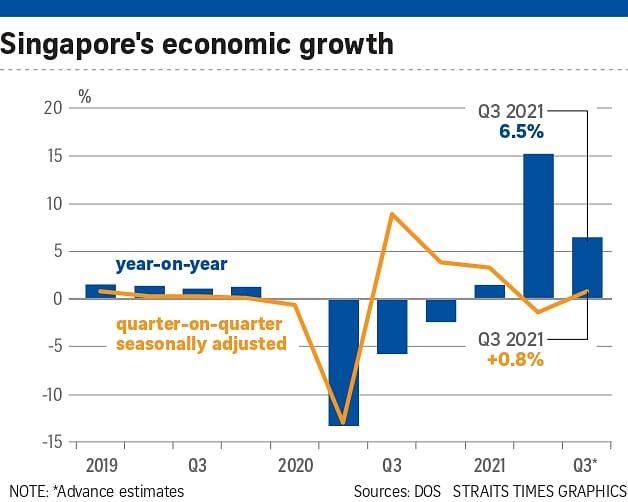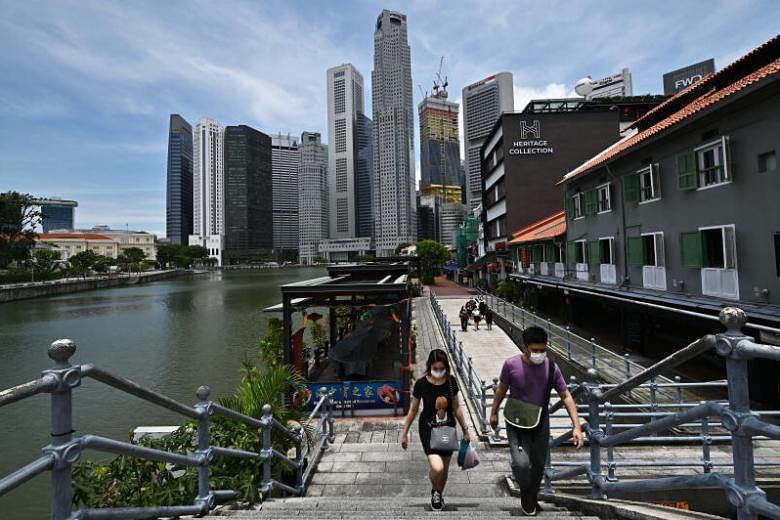SINGAPORE - Singapore's core inflation will continue to rise over the coming quarters because of higher business costs and continued import price pressures, the central bank said in its latest macroeconomic review published on Thursday (Oct 28).
The Monetary Authority of Singapore (MAS) noted in its biannual review that while business cost pressures have been relatively contained so far, they are likely to pick up next year due to factors such as the tapering of government support measures.
As the domestic economy reopens and private consumption picks up, these accumulating business costs will be passed on to consumers.
On the external front, disruptions to global food production and consumer goods supply chains will likely take time to ease, it added.
Inflated shipping and delivery costs, as well as material costs, that have weighed on firms' margins could also be passed on to consumers in the coming year, especially if demand persists.
For example, continued semiconductor chip shortages for at least another year could lead to the prices of consumer electronics remaining firm, MAS noted.
The ongoing logistics crunch could continue to push global food prices higher, which would lead to Singapore's imported food price inflation increasing further in the coming months and non-cooked food prices rising in turn.
Singapore's central bank tightened its monetary policy earlier this month in light of expected rising inflation, with the aim of ensuring price stability in the medium term.
MAS has forecast core inflation - which excludes accommodation and private road transport costs - to rise to 1 per cent to 2 per cent next year. Overall inflation is projected to average between 1.5 per cent and 2.5 per cent.
Core inflation in Singapore rose in the third quarter of 2021 due mainly to external factors such as higher energy and food prices. Rising wage costs were also likely reflected in the prices of some consumer services.
In its review, the central bank noted that globally, inflation has risen faster in economies where demand recovery has been stronger, such as in the United States and the euro zone.
In contrast, the slower recovery in demand in many Asian economies has weakened the pass-through from the rise in upstream costs to consumers.
Maybank Kim Eng senior economist Chua Hak Bin noted that besides rising energy and food prices, domestic price pressures are increasingly a concern.
"Rising wage and logistics costs are partly being passed on consumers via higher prices," he said, citing how the food and beverage sector is raising menu prices due to costs, despite grappling with challenges due to the Covid-19 pandemic and heightened restrictions.
Wage pressures may also be showing up in healthcare costs, Dr Chua added.
CIMB Private Banking economist Song Seng Wun noted that external inflationary pressures are likely to persist, given that global supply chain disruptions remain a concern and material costs continue to go up.
He noted that with demand recovering, continued supply-side constraints would mean higher prices are inevitable.

Demand for labour to rise in 2022
MAS also said that Singapore's labour market recovery remains broadly on track, even as heightened alert measures to curb Covid-19 infections had some temporary dampening effects in the second quarter of the year.
Demand for resident and non-resident workers is expected to rise in 2022 as the economy expands at an "above-trend pace", it added.
However, it pointed out that the overall level of employment may not rise back to the pre-Covid-19 level even by the end of 2022, in part because firms are expected to raise labour productivity and demographic factors continue to weigh on resident workforce growth.

The central bank expects resident employment to continue expanding in 2022, although it could slow from this year as resident labour slack is further absorbed.
"As the labour market tightens and business and worker confidence recovers alongside steady economic expansion, resident wage growth is anticipated to strengthen next year," MAS said.
Non-resident employment is also expected to stabilise and then rise gradually as Singapore progressively shifts towards managing Covid-19 as an endemic norm and as vaccination rates in the region improve, allowing more workers to enter.
But MAS also cautioned that a significant setback on the path out of the pandemic or weaker-than-expected global growth could slow the pace of the labour market recovery in Singapore.

Government policies aimed at improving the outcomes of lower-paid Singaporeans - such as the extension of the Progressive Wage Model to the retail sector and the extension of the local qualifying salary requirement to all firms which employ foreign workers from September 2022 - will also add slightly to overall wage growth in the economy, MAS said.
It highlighted that demand for labour will likely continue to rise at a firm pace in sectors such as information and communications, health and social services, and financial and insurance services. In these sectors, employment and job vacancies have both exceeded pre-pandemic levels, suggesting tightening in labour market conditions.
There could also be higher non-resident wage costs for sectors where firms need to retain existing workers, such as in construction and manufacturing, MAS added.


